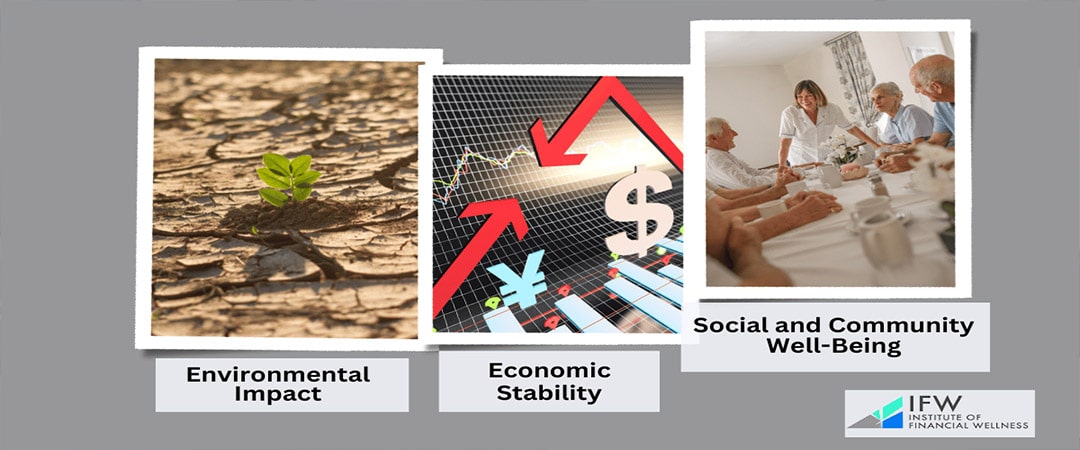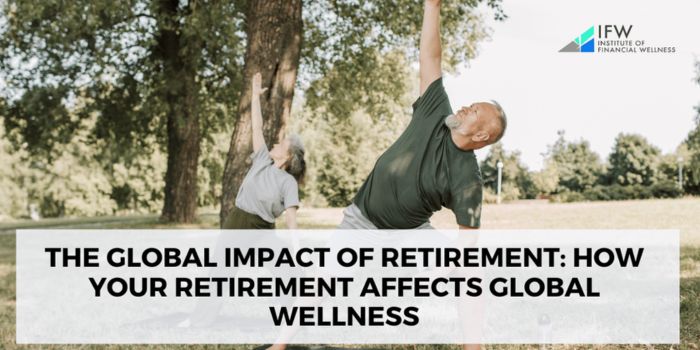“The most important thing is to enjoy your life—to be happy—it’s all that matters.” – Audrey Hepburn
Global wellness looks at health and well-being across different nations, encompassing factors such as health, income, and retirement systems. Why do some countries have better wellness outcomes than others? One significant aspect is the differing retirement ages and systems across countries. For instance, the statutory retirement age varies widely, with some nations allowing early retirement without penalties, while others have higher current retirement ages and tax early distributions from retirement accounts heavily. In other words, the retirement score varies from nation to nation.
The social security administration in each country sets rules for receiving benefits, including age requirements and conditions for employer contributions. The length of a full career affects retirement savings, with longer careers often leading to higher retirement benefits, while early retirement may result in reduced pension income, impacting a retiree’s ability to cover living expenses. Automatic enrollment in retirement plans and the level of employer contributions also significantly enhance retirement savings.
Buckle up, and let’s look at global wellness and retirement in more detail! And since you’re here, do you have an idea of what your retirement score looks like?
Key Takeaways
- Global wellness is a multifaceted concept involving both objective and subjective well-being, with significant disparities in health metrics such as life expectancy across different countries.
- Physical health trends globally are shifting towards increased fitness activities, while non-communicable diseases like obesity remain prevalent, straining healthcare systems.
- Innovations such as telemedicine, wellness apps, and wearable technology are transforming global health by improving access to medical care and encouraging proactive health management.
Understanding Global Wellness

Health encompasses more than the mere nonexistence of illness. As outlined by the World Health Organization‘s definition, it represents an intricate blend of total physical, mental, and social well-being. This comprehensive perspective navigates our comprehension of health on a global scale. The measurable facets, such as behaviors related to health and physiological indicators,, make up objective aspects within this complex mix, while psychological elements like joy and fulfillment in life represent subjective components.
Retirement is a significant life transition that profoundly impacts both physical and mental wellness. Nevertheless, there is variability in how these aspects interact with each other during this phase. For instance, while some retirees experience enhanced well-being due to reduced stress and increased leisure time, others may face challenges like decreased social interaction or a sense of purpose, especially if they struggle with chronic diseases or conditions. The interaction between psychological state and physical condition can differ markedly between those who are generally healthy and those managing ongoing health issues.
Well-being in retirement is layered, involving both tangible measures and emotional experiences. Specific tools and metrics can assess physical health and financial readiness for retirement, but emotional and psychological aspects, such as finding purpose and maintaining social connections, are gauged differently. This multifaceted approach to well-being aligns with the principles of Blue Zones, which advocate for a holistic model of wellness. In these communities, promoting overall well-being integrates good health practices, purposeful living, and strong community ties, forming a dynamic model for flourishing wellness in retirement.
Retirees can enhance their physical health, maintain mental sharpness, and cultivate a sense of purpose by adopting Blue Zones’ principles. These elements are crucial for a fulfilling retirement, where well-being is not merely the absence of illness but a vibrant state of health supported by meaningful engagement and robust social networks.
Global Wellness Day: Embracing Holistic Health and Financial Well-Being
Global Wellness Day, celebrated annually on the second Saturday of June, is a social project dedicated to living well and raising awareness about the importance of healthy living. Originating in Turkey in 2012, the day has now become a worldwide event marked by activities such as yoga sessions, fitness classes, workshops, and seminars, all promoting physical, mental, and emotional well-being. The goal of Global Wellness Day is to encourage people to pause and think about how they can live healthier and happier lives. By providing free and accessible wellness activities, it aims to inspire positive lifestyle changes and to spread the message that wellness is not a luxury but a necessity [1].
Financial well-being is intrinsically linked to overall wellness, and Global Wellness Day highlights this connection. Financial stress is a significant source of anxiety and can adversely affect mental and physical health. By promoting a holistic approach to wellness, Global Wellness Day encourages individuals to also consider their financial health. This involves managing finances effectively, reducing debt, and planning for future financial stability. Financial wellness can lead to less stress, improved mental clarity, and a better quality of life, thereby contributing to one’s overall sense of well-being. Thus, Global Wellness Day serves as a reminder that taking steps toward financial health is just as crucial as physical and mental health in achieving a balanced and fulfilling life.
Wellness Metrics Across Different Countries
Our interconnected world presents a complex mixture of health metrics that reveal stark differences among nations. For example, life expectancy—an essential measure of overall health—exhibits profound variation from country to country. Globally, the average lifespan at birth stands at 73.4 years, with women living five years longer than men. Various elements contribute to such discrepancies in longevity [2].
When examining these variations more closely, there appears to be a link between investment in healthcare and improved wellness outcomes. Countries like the USA, Germany, and France invest significantly in their healthcare systems—a sizable share of their GDP—and this is reflected in higher life expectancies for their populations. On the other hand, OECD countries across Central and Eastern Europe, as well as Latin America, allocate only about 6% to 9% of their GDP towards health expenses [3].
Consequentially, they report shorter lifespans on average compared to wealthier nations. Furthermore, Mexico is Luxembourg. Türkiye, whose investments are less than % of this threshold, experiences even more pronounced hurdles regarding citizens’ well-being. These uneven patterns emphasize the importance of devising global strategies that aim for equitable access to better quality care services.
Physical Health Trends

Global consciousness surrounding physical well-being is experiencing a transformative shift, with an increasing emphasis on maintaining robust health. The rise in popularity of fitness pursuits such as strength and bodyweight training, along with tailored programs for the elderly, signifies this worldwide dedication to fostering better physical wellness.
We will delve into specific facets of physical health, including life expectancy, prevalent illnesses, and healthcare infrastructures.
Life Expectancy
Life expectancy serves as a reflection of a nation’s overall health, representing the average lifespan expected for individuals in a specific group. Consider Mia and Ava, who both celebrate their 62nd birthday in April 2011—an age not far from the current threshold for retirement. By utilizing tools such as the Life Expectancy Calculator from the Social Security Administration, they can get an estimate of how long they might live—a number that may vary widely due to factors like access to healthcare, lifestyle choices, and economic status.
Understanding life expectancy is crucial because it plays a pivotal role in planning for retirement. Taking another look at Mia and Ava: If Mia wants to retire early but then finds out she could live longer than she initially thought, she’d need to increase her savings so her financial resources don’t run out during her extended lifetime. On the flip side, Ava—who has been eyeing working until full career completion—may discover that thanks to favorable life expectancy projections combined with adequate savings on hand. Retiring earlier than planned could be financially viable after all. In essence, expectations about our lifespans influence significant decisions regarding when we choose or are able to stop working—as well as how much we need (and when) to start stashing away into those all-important retirement funds.
Common Diseases and Conditions
The health landscape across the world is heavily impacted by non-communicable diseases (NCDs), which account for 63% of deaths globally. A significant and worrying part of this problem is obesity and overweight, affecting 2.1 billion individuals worldwide. These issues intensify existing health challenges and put additional pressure on healthcare systems, highlighting the need for preventive approaches to wellness.
Healthcare Systems
The healthcare systems across the globe are as varied as the countries they serve. The International Profiles of Health Care Systems offer an in-depth understanding of how various nations organize, manage, and fund health systems. Central to healthcare reforms globally is the focus on enhancing quality of care, managing expenses effectively, and striving to eliminate inequities.
The COVID-19 pandemic highlighted the vital importance of having access to affordable, efficient, and equitable health services. Countries such as Germany, Japan, and Switzerland, with their highly rated and thorough healthcare structures, were better equipped during this crisis.
Consider these examples:
- In Germany’s combined public-private system, widespread access to a range of medical services is maintained.
- Japan’s comprehensive insurance coverage guarantees every citizen receives necessary medical attention.
- Highly esteemed for its mixture of public support and private subsidies plus entirely private insurance offerings, it makes up Switzerland’s healthcare model.
These cases highlight how powerful healthcare infrastructures contribute significantly towards maintaining overall physical well-being in different countries.
Mental Health and Well-Being

In the complex web of worldwide health, we arrive at a vital crossroad: mental health. It is an escalating issue touching hundreds of millions annually and even more throughout their lifetimes. The COVID-19 pandemic has intensified these mental health challenges, leading to heightened levels of depression, anxiety, and stress.
Although there are effective treatments for these conditions available, numerous individuals either obtain subpar treatment or go untreated altogether. We will delve into mental health statistics and examine the availability of services and societal perspectives concerning this aspect of wellness.
Mental Health Statistics
A substantial segment of the world’s population is affected by mental health issues, with various common conditions afflicting individuals. For instance:
- It is anticipated that major depression will impact one out of every three women and one in five men during their lives.
- Schizophrenia, although not as prevalent, has a considerable influence on those affected.
- Bipolar disorder also affects fewer people but can profoundly alter an individual’s life.
These examples underscore the critical need for increased awareness and support regarding mental health.
Yet, how global occurrences like the COVID-19 pandemic affect psychological well-being depends on several factors, including national healthcare policies, societal resilience to stressors, and cultural attitudes toward such crises. A country equipped with strong healthcare infrastructure and resilient populations may experience less severe effects on its citizens’ mental health than countries lacking these supports.
Access to Mental Health Services
The provision of mental health services varies widely among different countries, presenting a complex global issue. Countries with high income levels tend to have an abundance of psychiatric care options, while those with lower incomes may suffer from a lack of trained mental health practitioners. The healthcare infrastructure in place, the level and quality of training received by professionals, and the extent of government funding are all factors that contribute to the standard of available mental health services.
Yet even as these disparities exist on an international scale, inequalities can also be found within individual countries. Mental health resources are frequently more scarce in rural locales than in urban centers. The cultural stigma surrounding mental illness can impose additional barriers to accessing necessary treatment in certain communities. This uneven distribution underscores the critical need for equitable access to superior mental health support worldwide.
Cultural Attitudes Toward Mental Health
The way mental health is viewed and handled is shaped by cultural beliefs. For example, throughout the COVID-19 crisis, how various communities recognized risks and coped with anxiety was influenced by their specific cultural perspectives on mental health.
In several cultures, individuals feel uncomfortable discussing symptoms of their mental health with healthcare providers or acquaintances. This discomfort establishes an obstacle that impedes reaching out for essential help regarding their well-being.
Social Well-Being and Community Support
Navigating the terrain of wellness, it becomes clear that social well-being and community support are essential in accessing benefits. These elements act as a protective buffer in times of stress and adversity, greatly improving one’s overall state of health.
The complexities surrounding social ties, initiatives from both governmental bodies and non-governmental organizations (NGOs), as well as the influence of financial security will be explored further.
Social Connections
Our ties to the community serve as vital connections that bind us, offering emotional support, empathy, and a feeling of inclusion. These bonds afford us the chance for self-improvement and learning by allowing us to acquire new competencies and insights. When confronted with life’s difficulties, the emotional backing provided by social relationships is indispensable. It serves as protection during tough times.
Social connections confer multiple advantages, such as:
- cultivating empathy and improving communication skills
- reinforcing unity within communities
- nurturing a sense of purpose and belonging, which are fundamental for psychological well-being
For example, in areas known as Blue Zones, where people enjoy longer lives filled with healthiness—community integration and shared experiences greatly contribute to their prolonged vitality.
Government and NGO Initiatives
In conjunction with governments and NGOs, the private sector plays a vital role in the health scene by pooling resources and expertise through collaborations. These joint efforts are essential for triumphing over health inequities and advancing overall global well-being.
On the front lines of wellness, government bodies and non-governmental organizations (NGOs) implement social strategies that extend their reach to populations often left behind. Their endeavors encompass a range of initiatives, from providing healthcare services to imparting educational programs—all designed to close gaps within society’s wellness landscape.
Impact of Economic Stability
Maintaining economic stability plays a crucial role in providing access to wellness initiatives and ensuring the general well-being of individuals. NGOs play their part in bolstering social progress by implementing microfinance programs and vocational training, paving the way for enduring income-generating opportunities. The morale and engagement levels within the workforce directly influence both productivity rates and quality of customer service, which are essential components of economic stability. Contributions from employers towards wellness schemes can reinforce this equilibrium.
Faced with fiscal challenges such as inflationary trends and escalating costs of energy, there’s an observable increase in programs aimed at financial well-being. For example, Nordic countries are leading efforts to adopt comprehensive approaches to welfare that include robust financial education geared toward improving overall well-being. These instances underscore the significance of having solid economic foundations as a means to promote widespread healthiness and prosperity.
Innovations in Global Wellness

In exploring the terrain of wellness, we come across transformative innovations that are reshaping health on a global scale. The emergence of digital health technologies, such as artificial intelligence and machine learning, has led to enhanced outcomes for people’s well-being around the planet.
We shall delve into these groundbreaking developments, examining telemedicine, wellness applications, wearable technology, and public health initiatives more thoroughly.
Telemedicine
Telemedicine is a beacon of innovation in the healthcare landscape. It facilitates remote consultations, monitoring, and diagnosis through technology, significantly improving healthcare access in underserved regions. The adoption of telemedicine surged during the COVID-19 pandemic, underscoring its potential to address healthcare disparities.
Telemedicine is not just a temporary solution; it’s a crucial part of modern healthcare. By allowing remote consultations, it significantly improves access to healthcare, especially in rural and underserved areas. By bridging geographical gaps, telemedicine is transforming the way we access and deliver healthcare.
Wellness Apps and Wearables
Health-focused applications and wearable devices are transforming the way we manage our personal wellness. Wearable technology, such as smartwatches and fitness bands, is at the forefront of fitness trends for 2024. These devices facilitate round-the-clock monitoring of health metrics to foster proactive management of well-being.
These wearables hold significant value in their ability to notify users about atypical health patterns promptly, thus encouraging timely medical attention that can prevent more severe health crises. On a parallel front, wellness applications deliver bespoke recommendations on maintaining or improving one’s health by analyzing data from daily routines and various physiological measurements. The integration of artificial intelligence into these apps has refined their ability to provide individualized guidance on maintaining good health.
The advent of these technological advancements grants individuals greater agency over their own healthcare decisions and practices.
Public Health Campaigns
Global wellness initiatives greatly benefit from the implementation of public health campaigns. Such campaigns were instrumental in elevating both consciousness and immunization frequency, especially amidst the COVID-19 crisis. These drives typically employ diverse multimedia platforms to widen their impact and foster greater participation.
These informational crusades are crucial as they disseminate knowledge to the masses while advocating for practices that positively affect one’s health. In doing so, they significantly advance overall health standards.
Retirement Wellness Planning: Its Impact on Global Wellness

Retirement wellness planning is a holistic approach to preparing for life after work, encompassing financial security, health management, social engagement, and personal fulfillment. As populations around the world age, the choices retirees make during this phase significantly influence global wellness trends, from environmental sustainability to economic stability. Let’s explore these impacts, highlighting how individual decisions collectively shape broader societal outcomes.
Environmental Impact
- Sustainable Living Choices: Retirees often reassess their living arrangements, opting for downsized homes or communities that emphasize sustainability. Choosing energy-efficient housing, reducing waste, and adopting renewable energy sources can substantially reduce the carbon footprint of this demographic. For instance, retirement communities that focus on green building practices and promote eco-friendly habits contribute to lower overall greenhouse gas emissions.
- Travel and Mobility: Retirees tend to travel more, which has a dual impact. While tourism can stimulate local economies, it also increases carbon emissions. However, retirees who prioritize eco-tourism and choose sustainable travel options, such as using public transportation or supporting environmentally conscious travel operators, help mitigate negative environmental effects.
- Consumption Patterns: With more time and often more disposable income, retirees’ consumption choices can influence market trends. Opting for locally sourced products, reducing meat consumption, and supporting businesses with sustainable practices drive demand for greener goods and services, encouraging industries to adopt more sustainable operations.
Economic Stability
- Financial Health and Investment: Sound retirement planning ensures that retirees remain financially independent, reducing the strain on public welfare systems. Investment in diverse portfolios, including socially responsible investments (SRIs), can promote ethical business practices and sustainable economic growth. Retirees who invest in green bonds or companies with strong environmental, social, and governance (ESG) criteria contribute to a more stable and sustainable economy.
- Healthcare Expenditures: Proper health and wellness planning can lead to better health outcomes, thereby reducing healthcare costs. A healthier retiree population lessens the burden on national healthcare systems, allowing for more efficient allocation of resources. Additionally, retirees who invest in preventive healthcare and wellness programs support industries focused on health innovation and disease prevention.
- Workforce Participation: Many retirees choose to remain active in the workforce through part-time jobs, consulting, or volunteer work. This continued participation not only provides a source of income but also leverages their skills and experience, contributing to economic productivity. Furthermore, engaging in mentorship roles helps transfer knowledge to younger generations, fostering a more skilled and resilient workforce.
Social and Community Well-Being
- Volunteerism and Civic Engagement: Retirees often have more time to dedicate to volunteer activities and community service. Their involvement in local organizations, non-profits, and civic initiatives enhances community cohesion and addresses social issues, such as poverty, education, and public health. By contributing their time and expertise, retirees play a crucial role in strengthening societal networks and support systems.
- Lifelong Learning and Education: Continued education and personal development are important aspects of retirement wellness. Retirees who engage in lifelong learning not only enhance their own well-being but also stimulate demand for educational programs and cultural activities. This, in turn, supports educational institutions and promotes a culture of continuous learning and intellectual growth.
- Intergenerational Interactions: Active participation in family and community life fosters intergenerational bonds. Retirees who engage with younger generations, whether through grandparenting, tutoring, or community programs, help bridge generational gaps and promote mutual understanding and support. These interactions can enhance the social fabric and ensure the transfer of values, knowledge, and traditions.
Empowering Lives: The Institute of Financial Wellness and Its Comprehensive Approach to Financial Education

The Institute of Financial Wellness (IFW) emphasizes the vital link between financial health and overall well-being. It is the most expansive multimedia network offering an array of financial and educational materials, resources, and services. Our mission is to assist individuals in achieving their fullest life potential. We pride ourselves on delivering some of the industry’s most captivating and impartial content for financial learning.
With our comprehensive suite of offerings encompassing everything from planning for retirement to managing college finances, we commit to maintaining the economic vitality of those we serve. We conduct webinars covering diverse fiscal subjects like student loan repayments that make understanding finance both accessible and stimulating. At IFW, mastering monetary education is informative and enjoyable, equipping people with the knowledge they need to steer their fiscal wellness confidently.
Full Summary
Throughout our journey into global wellness, we have navigated the complex web of physical, mental, and social well-being. We’ve scrutinized various health indicators from numerous countries and examined the obstacles as well as successes in attaining worldwide wellness. Innovations such as telemedicine, wellness applications, and wearable technology are transforming health care results around the globe. It’s important to recognize that organizations including governments, NGOs and entities like the Institute of Financial Wellness play pivotal roles in sculpting international wellness standards. Above all else is the recognition that true wellness requires an all-encompassing strategy which embraces every aspect of one’s health – a notion fundamental to this holistic concept. Moving forward on our path towards wellbeing lets us both acknowledge advancements made so far while also committing ourselves anew to fostering a more healthy and joyous global population.
Frequently Asked Questions
What is global wellness?
The concept of global wellness encompasses a comprehensive understanding that takes into account physical, mental, and social health. It integrates considerations like access to healthcare services and life expectancy as fundamental elements in assessing overall well-being.
What are some physical health trends?
Physical health trends include increasing life expectancy, prevalent conditions like obesity, and diverse healthcare systems.
Additionally, there is a growing global emphasis on fitness activities to improve physical well-being.
How does economic stability impact wellness?
Financial stability plays a crucial role in influencing well-being, as it affects the ability to access wellness initiatives and impacts overall health. Rising economic challenges like inflation and heightened energy expenses have led to a surge in programs aimed at enhancing financial well-being, for instance.
What are some innovations in global wellness?
Advancements in worldwide health such as wearable technology, wellness applications, and telemedicine are enhancing both the accessibility to healthcare services and the effectiveness of health outcomes, also facilitating tailored recommendations for individual health.
Incorporate these cutting-edge tools into your approach to actively manage your personal health.
What are some challenges to achieving global wellness?
Environmental issues, economic and political instability, as well as inequality represent significant obstacles in the pursuit of worldwide wellness. These challenges require urgent focus and intervention to be addressed effectively.




